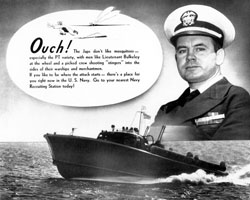During World War II, adroit navy public relations and obliging media coverage wrapped PT boats in glamour. Initially designed for dangerous nighttime attacks on much larger Japanese warships, the boats came to be seen as intrepid little heroes, America’s Davids taking on Japan’s Goliaths of the sea.
But the performance of the boats didn’t match the hype. The navy command viewed the PT as a stopgap vessel to give the United States badly needed firepower on the water as the country ramped up production of warships, according to Duane Hove’s afterword to the 40th anniversary edition of Robert Donovan’s 1961 PT-109: John F. Kennedy in World War II. To avoid tying up the steel ship construction yards, PTs were prefabricated from spruce, white oak, and mahogany covered with plywood. Initially, the boats were armed with Mark VIII torpedoes, leftovers from World War I that often proved defective. Only one in four boats was equipped with radar—a fact that explains some of the confusion on the night of PT-109’s collision.
PT crews were not typically experienced sailors and received little training specific to their boat.
PT crews were not typically experienced sailors and received little training specific to their boat. “The first time I ever fired a torpedo was at the enemy!” complained one graduate of the two-month PT school in Melville, Rhode Island.
Among Annapolis graduates, the PT squadrons were known as the Hooligan Navy, in part because of their record of mishaps. During the invasion of New Georgia in the Solomons in June 1943, six PT boats mistook the flagship of the commanding American admiral, Richmond Kelly Turner, for an enemy vessel and torpedoed it. (Fortunately there was only a skeleton crew aboard; the ship had been badly damaged by an earlier air assault.) On another occasion, a PT boat was attacked in daylight by a North American B-25, which mistook it for a Japanese barge. The torpedo boat fired back and shot down the bomber, killing three crewmen.
Though few PTs sank major Japanese ships, they enjoyed more success in other operations, including reconnaissance and search and rescue. The boats often harassed and broke up Japanese barge traffic, earning the nickname “devil boats” among the enemy. During the 1944 Battle of Leyte Gulf, PTs provided vital intelligence on the movement of Japanese warships into Surigao Strait. And PT-137 scored a crippling torpedo hit on the light cruiser Abukuma.
At the close of the war, the PT fleet was dismantled. All but a few boats were destroyed, sold, or given to other countries.






